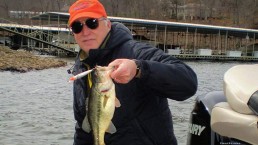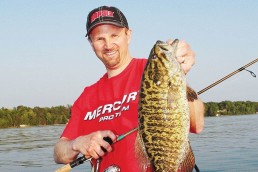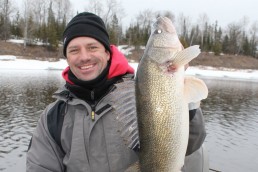Jerkbait Season: Here’s what You need to Know
SHARE THIS POST
Neither Lauri Rapala nor Jack Smithwick could have anticipated the radical way their inventions would affect the nature of coldwater bass fishing. Both designed lures that work well when water temperatures hover in the 38- to 48-degree range, albeit years apart.
Rapala trolled his lures on long lines in Finland’s lakes to catch fish that he sold at the market and for his family’s personal consumption. Trolling a lure instead of live bait increased his productivity because the homemade, minnow-shaped balsa lures saved time by not having to put fresh bait on the hooks every time he caught a fish.
Smithwick saw the need for a lure that looked and behaved like a Rapala Minnow but weighed more so that it could be used with a baitcast rig. He carved early creations from the sturdy wood of broom handles, and soon it became apparent that when fished slowly this lure was deadly for bass in the cold-water period. Anglers learned the best way to catch bass under these conditions with the slender, minnow-shaped lure was to cast it out to an ideal area and then use a twitch retrieve with excruciatingly long pauses.
Many jokingly gave out the advice, “Cast it out, twitch it a time or two, and then smoke a cigarette before twitching it again,” while others recommended, “If the water is really cold, eat a sandwich between twitches.” Because of the retrieve method—about the same time Smithwick’s Rogue lure became famous—it would become known as a “jerkbait.” Synonymous terms used for this lure style include floating minnow, minnow bait and stickbait, while others used the moniker “rogue,” even if the lure was thought or known to be of another manufacturer.
The common method of fishing the jerkbait is to cast, reel a few feet to its running depth, and then use the pause-twitch retrieve. Unfortunately, because of its buoyancy, this lure seldom attracted fish deeper than 5 to 6 feet. Anglers, being a creative bunch, then began devising ways to make the lure suspend or sink during a retrieve. Some switched to larger hooks; others wrapped a few turns of wire solder around the front or middle hook.
Then along came tournament pro Jim Morton who created the SuspenDot and SuspendStrip, a weighted lead tape with dots or strips that stick onto a lure to decrease its buoyancy. Some golfers/part-time anglers also discovered this adhesive lead tape and used it to fine-tune their clubs, but the fishermen used it most for altering the buoyancy of their jerkbaits.
Are you enjoying this post?
You can be among the first to get the latest info on where to go, what to use and how to use it!
Today there is a plethora of jerkbait brands and models. Along with Rapala and Smithwick Rogue, the Bass Pro Shops online catalog lists 115 different models from 21 manufacturers that float, suspend or dive. While the gold standard of jerkbaits for coldwater bass has been the Smithwick Rogue, new versions from many manufacturers have made significant inroads on the tournament trail. Some feature weight-forward casting or significantly improved finishes that are very lifelike. Interestingly enough, the method or technique of slow retrieves and long pauses remains the same for each model.
Colors of these baits follow accepted practices of being “realistic” for clearer waters, and brighter versions of chartreuse for the stained areas. But manufacturers do have specialty colors that mimic lake-specific forage like the blueback herring found in the southeast. Anglers should always check for top-selling colors when they are fishing unfamiliar lakes or should go get advice and always read about what to use.
While not heavily used during the cold-water period, there is a long list of soft plastic shad imitators from Bass Pro Shops, Berkley and Zoom, whose Fluke and Super Fluke have pioneered the soft plastic jerkbait platform.
Frankly, there is no reason to avoid soft plastic jerkbaits in water temperatures above 45 degrees still present in more southern waters. Since the jerk-pause-retrieve does not rely solely on the lure’s flexibility, there is much to be said about the slow-falling erratic action of the “Fluke-like” presentation, especially along the bluffs and bluff ends of highland and hill-land reservoirs. Of course, it should be remembered that spinning gear rigged with monofilament or flexible braid in 10- to 15-pound-test is more than adequate for fishing around rocky points, sun-drenched shorelines and steep bluff walls.
Finally, for jerkbait fishing sometimes it just doesn’t work—usually because bass can be very lethargic in late fall into December and January where there is still open water. When this happens, try working rocky ledges along steep bluffs with a 4-inch, pre-rigged soft plastic worm like those made for bluegills and crappies. Other options include a Berkley 4-inch Power Worm rigged on a Lindy-Little Joe Max-Gap jig or similar rig. Cast these on light-spinning gear then allow the lure fall to a ledge. Then drag it very slowly back from ledge to ledge and rock to rock. You’ll be amazed at the number and quality of fish this method produces when all else fails in the colder waters this season.
MWO
SHARE THIS POST
Did you enjoy this post?
You can be among the first to get the latest info on where to go, what to use and how to use it!
Darrell Taylor
Darrell Taylor has fished for more than 65 years. During the past 25 years, Taylor has generated more than 2,000 published articles, columns and fishing reports. His writings received 14 peer-level awards from outdoor writer organizations, including the Association of Great Lakes Outdoor Writers “Excellence in Craft” Golden Glow Award, their highest recognition.



